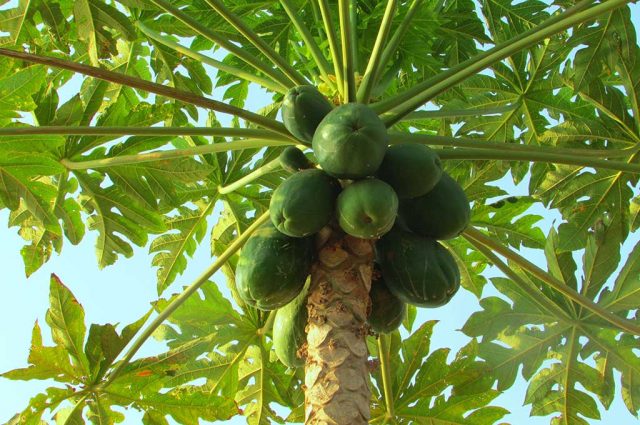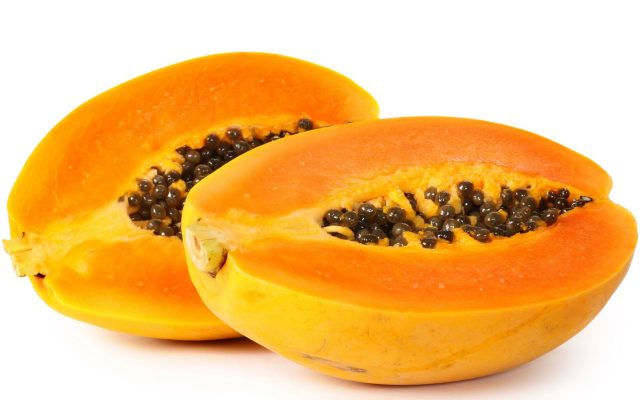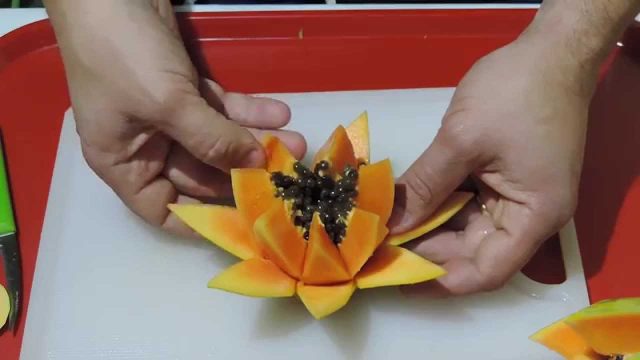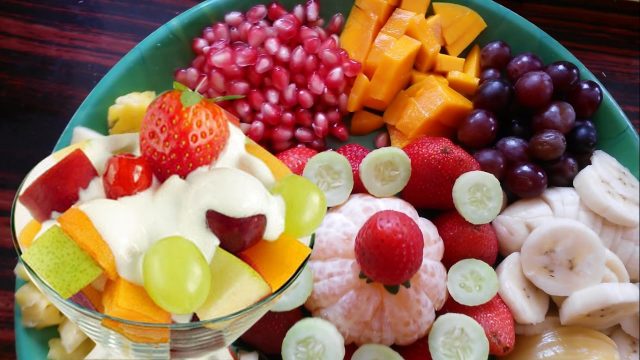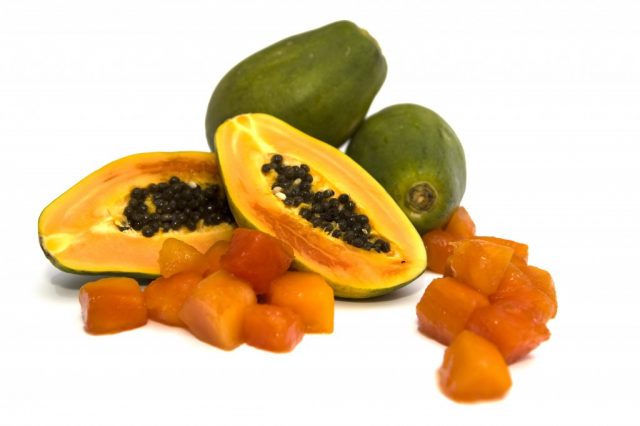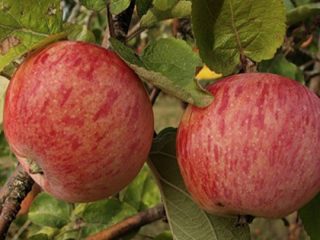Content
Today papaya can be eaten not only in tropical countries. Originating from Central America and South Asia, the culture has taken root in Mexico, Africa, India, USA, Hawaii. For Thailand, papaya is a traditional product, purposefully grown and is included in most of the national dishes. In Russia, the fruits are not yet so popular, therefore, not everyone knows how to properly cut and eat an exotic fruit.
What does papaya look like?
The plant looks like a coconut tree, but, strictly speaking, is not a tree. Young papaya develops surprisingly quickly, the hollow trunk can reach 10 m, although its typical size is about 5 m. The top is crowned with a dense rosette of large leaves that grow up to 70 cm in length. The fruits are concentrated in the crown and emerge from the axils of the leaves near the trunk, which completes the plant's resemblance to a palm tree.
The papaya begins to bear fruit within 6 months after germination, for which it is often called the tree of the impatient gardener. In the Thai climate, which is the most favorable for culture, it is eaten all year round, as buds are set constantly and ripening is not tied to the seasons.
The appearance of large varieties of papaya justifies its other name - "melon tree". The oval fruits resemble sweet melons in color and shape. Even their taste is considered by many to be similar. So Asian or Caribbean varieties usually weigh more than 3 kg, there are especially large specimens up to 7 kg. Small varieties, most often Hawaiian, are pear-shaped.
When ripe, the green peel acquires an orange or yellow uniform color. Most Thai varieties differ in their small size and fruit color from yellow to amber. Ripe pulp is juicy, firm, rich orange, sometimes with a pink tint. In the center of the papaya, as seen in the cutaway photo of the fruit, there are concentrated black, round seeds entwined with dense fibers, which makes it even more like a melon.
What papaya tastes like
The taste of papaya is not very familiar to the Russian consumer. Many people prefer to eat it only as part of restaurant dishes. Ripe pulp is compared to boiled carrots, ripe melon, and the aroma reminds many of raspberries or peaches. The shades of taste depend on the variety, country of origin and degree of maturity. The average characteristics of a quality fruit are juiciness, sweetness, refreshing taste without signs of bitterness.
Unripe papaya can be eaten as a vegetable, it does not have a pronounced fruity taste. Green fruits are often bitter. Representatives of peoples cultivating culture for centuries can eat bitter specimens without consequences. Overripe fruit loses its sweetness and firmness. It is not recommended to eat such pulp.
The crop's ability to ripen after harvest helps to send it around the world. However, the taste of such fruits does not reach the sweetness and aroma of those ripened on the tree. Therefore, a complete picture of a quality fruit can be obtained only if you buy and eat papaya in the countries where it grows.
How to choose a ripe papaya fruit
Since the degree of ripeness directly affects the taste, it is very important to choose the right papaya.Before evaluating the fruit by ripeness, be sure to inspect the surface for the presence of dents, cuts, cracks, dry areas of the peel. Any damage to the integrity suggests that eating such fruits is harmful and sometimes dangerous to health.
Criteria for ripeness and freshness of papaya:
- The color is even, without dark spots, burgundy stains are acceptable. The amount of green tint on the peel of yellow varieties should not exceed 1/5. Such papaya has a better chance of ripening at home.
- The smell is distinct, more pronounced at the stalk. May resemble raspberries, peaches, melons. A sugary-sweet aroma may indicate that the papaya is overripe and cannot be eaten.
- The pulp is elastic, springing when pressed. Hard, "stone" surface in immature specimens. The soft fruit, on which marks remain after pressing, is overripe.
Papaya should not be eaten with the following signs of chemical processing during cultivation or transportation:
- sticky peel;
- lack of smell with bright colors;
- pronounced veins on the surface.
To determine the ripeness of green papaya varieties, you can use the same criteria, excluding color. Freshness and safety are rated similarly.
How to peel papaya
The peel of the fruit is not eaten, but the fruit must be thoroughly washed before processing. It is important to remove from the surface not only dust, microbes, but also traces of chemicals used in the transportation of any tropical fruits. To do this, pour boiling water over the papaya and wipe it dry, or wash it with a soft brush under running hot water.
Ripe peel is thin, tender. You can easily peel the papaya before eating with a sharp knife or potato peeler. But for convenience, the fruit is first cut lengthwise and in half. The seeds are removed, and only then the skin is removed. Otherwise, you can lose some of the juice or crush the tender pulp.
How to cut papaya
From the center of the fruit cut in half, the bones and fibers are removed, like from a melon. To do this, you can use a regular spoon. Next, the pulp is cut in several ways:
- long slices together with the peel to be eaten like melons;
- the peeled halves are cut into cubes and poured into a salad or fruit bowl;
- make perpendicular cuts, capturing only the pulp, leaving the peel intact, after which the fruit can be "turned out" for an effective serving to the table.
The best way to eat raw papaya is diced with a fork or chopsticks. But the pulp of a ripe fruit is so pliable that you can simply use a spoon after cutting the fruit in half.
How to eat papaya
Acquaintance with an exotic fruit should be started gradually. For the first time, you need to eat raw papaya in small portions, tracking the body's possible reactions to unfamiliar food. Ripe fruits contain latex juice, which can sometimes cause allergies.
How can you eat papaya raw?
High-quality, ripe fruits are not only tasty, but also healthy. Trace elements, vitamins, valuable organic compounds in the composition are better preserved if the papaya is eaten fresh, without subjecting it to heat treatment.
The fruits are very nutritious and can be eaten alone or as part of complex meals. Their use is universal: they can complement the taste of vegetable salads or fruit mixes.
In salty dishes, raw papaya goes well with cheese, tomatoes, and game. These salads or side dishes can be eaten with any suitable sauce, including fish and garlic. Smoothies are traditionally made from Mexican varieties of papaya.
In sweet prefab desserts, fruits can be paired with tropical or local fruits and berries. Any creams and syrups are suitable for the delicate taste of papaya.
The ripe, sweet pulp makes it easy to make a fruity sorbet. It is enough to beat the papaya with water and sugar with the addition of a small amount of lemon juice. The mass should be frozen in any convenient form and eaten like ice cream. The delicate taste of the dessert can be supplemented with any berries, optionally combined with fruits. This sorbet is especially pleasant to eat in the heat.
Using a blender, you can make a fragrant mass from milk, papaya pulp, sugar, vanilla. The drink is chilled and served as a cocktail. If desired, the mass is made thicker, and then frozen to be eaten as a sorbet.
Can papaya seeds be eaten?
The dark, round grains removed from the fruit during peeling are usually thrown away. But in the homeland of tropical fruits, seeds also have their uses. The grains, similar to black peppercorns, taste like this hot spice. Sauces, first and second courses are seasoned with ground seeds.
In Japan and China, grains are used to cleanse the body of toxins, as an antidote and for liver diseases. Doctors from Nigeria have documented the antiparasitic effect of taking the seeds.
Grains can be eaten whole, chewed or ground into a powder. For humans, such a pepper substitute is non-toxic, but requires gradual addiction. To test the tolerance of the product, it is enough to chew and swallow one papaya grain. In the absence of unexpected reactions, the intake can be continued, but during the first week, you should eat no more than 2 seeds per day.
How can you make papaya
Papaya is not only eaten raw. There are many options for using valuable pulp in different cultures and cuisines of the world:
- Unripe fruits can be cooked like potatoes. Pieces of pulp boiled in a small amount of water can be eaten, seasoned with salt, pepper, vegetable (preferably olive) oil.
- Green specimens in Thailand and Vietnam are stewed and eaten as a vegetable. In meat stews, papaya can be substituted for zucchini or pumpkin.
- The baked vegetable can be eaten without any additional seasonings. It smells like fresh baked goods, for this plant is called "breadfruit". When making pulp buns, the dessert taste is complemented with nuts, spices, and dried fruits.
- The fruits contain a large amount of pectin, which makes various desserts gelatinous. Original jams and preserves are obtained from the pulp.
- With a sauce made from pulp and seasoned with ground seeds, you can eat any meat dish. Often ginger root and chili pepper are added to the recipe for pungency.
In some countries, papaya is specially harvested in "vegetable" ripeness for the preparation of main dishes. The fruits ripened on the tree acquire aroma and sweetness, they are preferred to be eaten as a dessert.
What to do if you cut a papaya and it is not ripe
The transportation of the fruit around the world is possible due to its ability to ripen after being removed from the plant. If the purchased copy turns out to be green, you can leave it for several days in a warm place to ripen. Fruit will not ripen in the refrigerator and at low temperatures.
You can speed up the process by placing the fruit next to the bananas. It is not recommended to keep papaya in polyethylene, therefore, for ripening, fruits are laid out in food containers or paper bags. The ethylene gas emitted by the banana will speed up the process, and the ripe fruits can be eaten in a day.
If it was not possible to ripen the papaya or the fruit has already been cut, then its pulp can be boiled or stewed. Unripe specimens contain an alkaloid that is aggressive for an unprepared stomach and cannot be eaten raw.
Why papaya tastes bitter
Until ripening, the pulp of the fruit is permeated with tubular vessels carrying bitter juice. This milky liquid contains papain alkaloids that can cause stomach upset. In the process of ripening, the pulp acquires sugars, and the vessels become thinner and indistinguishable. Ripe papaya contains minimal amounts of the substance.
The chemical activity of bitterness made it possible from ancient times to use the plant to soften tough animal fibers. Meat, grated with papaya pulp, becomes soft, retains freshness longer. The concentrated extract from the fruit is produced today industrially for use in cooking.
Not only unripe fruit can taste bitter. Some Mexican papaya varieties have a slight bitterness even after full ripening. These fruits are large in size and have red flesh. They can be eaten raw despite the tangy flavor.
How to store papaya at home
Traditionally purchased fruits are immediately placed in the refrigerator. But there are some special storage rules for papaya:
- The papaya is placed in the refrigerator only as a last resort, for example, to preserve the chopped pulp. After 3 days, the taste begins to weaken.
- Whole fruits spoil quickly in plastic bags. Better to use cling film to wrap the papaya tightly.
- In the conditions of an ordinary apartment for fruit, they try to find a shaded cool place. Direct sunlight causes fruit to rot.
- Fruits try not to lay in layers, otherwise the delicate pulp is easily crushed and spoiled.
How much papaya is stored
The plant is especially sensitive to temperature extremes. Moving from room to refrigerator and back again can ruin the product in a matter of hours. It is correct to eat chilled papaya, but it is better to get the fruits to the table in portions, without subjecting the stored fruits to tangible fluctuations.
Optimal conditions for long-term storage of fruits:
- temperature not higher than + 10 ° C;
- humidity in the range from 85 to 90%;
- lack of contact with other fruits or food.
If you manage to create such a regimen, the ripening papaya will last longer than 10 days. Ripe fruit should be eaten within 7 days. Temperature change affects the shelf life of tropical fruits in this way:
- Above + 20 ° C - no longer than 3 days.
- + 5 ° C - about 7 days;
- At constant + 10 ° C - 14 days.
Papaya pulp does not tolerate freezing well. Such storage spoils not only the taste, but also the consistency of the fruit.
Conclusion
You can eat papaya at any age, without health restrictions. The only caveat concerns the period of pregnancy and is associated with the unusual nature of the plant for Russian latitudes. The rest of the product is very useful and interesting, and its versatility allows you to try papaya in salty, sweet dishes, drinks and find your own way of using this unusual fruit.
